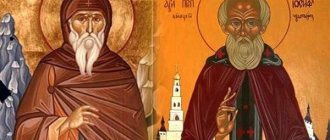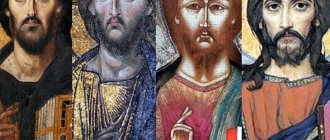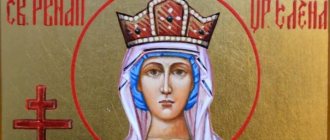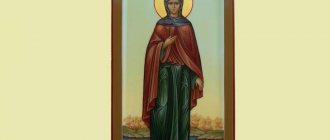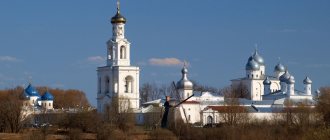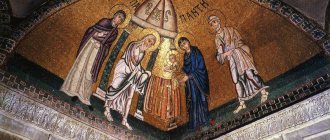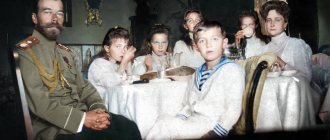4.6
Average rating: 4.6
Total ratings received: 218.
4.6
Average rating: 4.6
Total ratings received: 218.
The dispute between the Josephites and non-covetous people is connected with the religious life of the Grand Duchy of Moscow at the turn of the 15th-16th centuries. Its participants defended different points of view on the organization of monasteries.
Definition
Josephites and non-covetous people are representatives of the church-political movement who advocated different ideologies.
Many aspects of the spiritual issues of those years remain relevant today. In the 15th-16th centuries, the church always took part in the fate of the country, and many events took place without the intervention of a spiritual organization.
Ideology of movements
The ideological credo of the Josephites and the “Trans-Volga elders” was significantly different.
For the spiritual leader of the “elders” Nil Sorsky, faith in the Lord was an exclusively personal matter for each believer, because everything important happens not in the material world, but in the soul. Hence the call to non-covetousness as a way to achieve complete inner freedom for impeccable service to God.
The “Trans-Volga elders,” including Maxim the Greek and Vassian, did not recognize the nationalization of the Church, reducing the role of monasticism to:
- the ceaseless struggle for the soul of man;
- prayers for the flock and clergy.
Managing the lands and the laity is the task of earthly rulers. In the first years of the reign of Ivan IV, this concept was approved on his part, and in the closest circle of Grozny, the “Chosen Rada,” the main roles were played by priest Sylvester, boyar Adashev and Prince Kurbsky, who sympathized with the views of the Nile.
At the turn of the 15th-16th centuries, the Josephites had difficulty finding agreement with Ivan III, who in those years was more inclined to listen to Elder Nile and was hatching plans to return monastic landholdings to the state.
Dissatisfied with the possibility of secularization, as well as with the condescending attitude of the Grand Duke towards heretical “Judaizers”, for example, towards his close associates, clerk Fyodor Kuritsyn and Archpriest Alexei, Joseph created a theory according to which the ruler is, first of all, a man, although appointed to “divine service” .
In his work “The Enlightener,” Volotsky pointed out that a worldly prince may make mistakes that could destroy not only the ruler himself, but also all his subjects. According to Josephus, which was later modified, a secular ruler should be revered; but princes have power only over the body, and they should be obeyed “bodily, not mentally.”
In addition, at that time Joseph believed that spiritual power was higher than secular power, and the church needed to “worship more” than the sovereign.
Nevertheless, the Josephites, based on the postulate of the responsibility of the worldly ruler for the inhabitants of his state before the Lord, saw his prerogative in caring for both the temporal and spiritual care of people, the protection of the true faith, and the protection of his subjects, including from the influence of heretics. Heretics corrupt the souls of people, and, therefore, are worse than robbers who encroach only on the “body”; This means that they need to be “burned and hanged,” as Archbishop Gennady of Novgorod put it.
Over time, the views of the Josephites on the relationship in the triad “Church - government - people” underwent changes, and they began to consider the position of worldly power not lower, but on an equal footing with church power. Joseph's followers proclaimed that it was a sin to disobey a worldly ruler, and even called for them to serve him as a Lord rather than as a man.
Non-acquisitive people recognized the idea of the government’s responsibility to the people, believing that the duty of the government is to “judge and protect.” For them, a real ruler chosen by God must be aware of his highest responsibility to the Lord and people, and observe moral principles in accordance with his status as God’s anointed.
On the contrary, according to the teachings of the Josephites, rulers are not just chosen by Heaven, they themselves are almost sacred personalities.
Therefore, their ideas were liked by the Russian princes and tsars to such an extent that they abandoned the gigantic land holdings of the church, receiving in return inaccessibility to control public institutions, that is, they became absolute monarchs.
Already under Ivan the Terrible, a discussion began on the issue of books. Being supporters of printed books that appeared in Rus' at that time, the non-covetous people pointed out a lot of mistakes made by copyists, which led to discord and “disorder” in church service and worldly life.
The Josephites perceived printing as another “Latin” heresy, arguing that for ordinary people “the honor of the Apostle and the Gospel” was a sin.
Comparison
The Josephites are followers of the Russian Orthodox Church of St. Joseph of Volotsk. It was he who laid the foundation for the extreme church-political movement, when monasteries had the right to own property and land.
The non-covetous people, led by Nil Sorsky, advocated that the monks completely renounce all property.
Saint Nil believed that monks should only engage in prayer and study the Scriptures; in addition, he believed that every elder should obtain food for himself only by his own labor. Sorsky also recorded his own thoughts in one essay entitled “Tradition and Rules.” In his opinion, only the sale of one’s works for a purely symbolic price or necessary alms from those who loved Christ were allowed, but it had to be minimal. Neil also believed that decorating the church was unnecessary and there should be nothing valuable in it.
The worldview of Joseph Volotsky was completely opposite, since he believed that it was quite possible to combine the wealth of the monastery with the non-covetousness of the monks. Although Joseph and Neal had very different opinions about whether the church should be rich or poor, there were other factors of hostility.
They also had different views on what the Orthodox faith should be, how spiritual and temporal power should interact, and what royal power should be. So, in the middle of the 15th century, two currents formed in the church - the Josephites and the non-covetous.
There is an opinion that the Orthodox teaching - hesychasm - had a serious influence on the worldview of Nil Sorsky. It was precisely this that was based on the unity of man with God, the possibility of self-improvement and contemplation of the Divine essence.
According to Neil, religion was supposed to be a personal choice of each person.
Non-acquisitive people believed that the main thing in life was to improve in the soul, and not in relation to the world. Also, non-acquisitive people advocated that the church and the state should not be united together. They were quite happy with the separation of church and secular life, since they believed that religion should be free from absolutely everything.
The monastic role should be limited to praying for oneself and others, thinking about the salvation of the soul; in turn, the king should be responsible for the lands. If the king is trying to rule the lands together with the church, then it is better for him to lose power altogether.
Spiritual leaders of associations
There were many differences in the worldviews of Nil Sorsky and Joseph Volotsky. Only there are no facts of their personal enmity. Abbot Nile died in 1508. No supporting documents have survived, but there is information that he was canonized. His views were later disseminated by Artemy Troitsky, Maxim the Greek and Vassian Kosoy.
The spiritual mentor of non-possessors was born in Moscow in 1433. In the worldly environment his name was Nikolai Maikov. At first he served in one of the orders, and then became a monk of the Kirillo-Belozersky Church. Most of all he loved to read books. He had a good memory and a tendency to analyze the material he read. The monk always reflected on new information, and then came to his own contradictory conclusions. Having received the necessary knowledge, he asked the mentor for a blessing and went to the holy place of Athos.
Charged with the spirit of grace on the Holy Mountain, he decided to build his own small temple. The location was chosen not far from the Kirillo-Belozersky Monastery, near the Sora River. That is why they began to call him Nil Sorsky. A dozen more students and associates served with him in his temple. Soon Neil wrote the “Charter on Living in the Hermitage.” It contained reflections on the true calling of a clergyman. He saw it in comprehending the providence of God and improving internal moral standards.
Sorsky considered enrichment at someone else's expense to be the worst sin. Therefore, the elder did not like monastic land ownership. He considered the accumulation of wealth to be the greatest evil among people. He advised priests and monks to adhere to the precepts of poverty and humility. That's why he fought for non-covetousness. This concept has many synonyms: unselfishness, nobility, generosity, disinterestedness. These are exactly the traits that real clergy should have. That is why Neil is remembered as a truly holy confessor.
The founder of Josephiteism, Joseph Volotsky, was called Ivan Sanin in worldly life. He was born in 1440. The birthplace of the future priest was the village of Yazvische not far from Volokolamsk. His father was a service man. At the age of 20, Joseph took monastic vows at the Borovsky Monastery. Soon the monk showed organizational skills.
A few years later, Volotsky built the Joseph-Volokolamsky Monastery. Soon the temple became one of the most luxurious in Rus'. The clergyman became a prudent owner, constantly increasing the wealth of the church and its possessions. The mentor chose the path of abstinence and led a strict lifestyle. He limited himself in receiving pleasure and using material goods.
For the remaining monks, a charter was developed with three categories of monks:
- Ordinary people were allowed bread and water, old worn-out clothes, and bast shoes on their feet.
- The richer monks were given hot food, good clothes and shoes.
- Elite servants were provided with fish dishes and rolls. They had two changeable outfits and a fur coat.
The luxurious temple of Volotsky was famous throughout Rus'. Joseph was revered by the Grand Duke of Moscow and the clergy. Over time, the mentor began to compose works about various church problems. The authoritative theologian gained fame.
Luxurious temple of Volotsk
The Church Council of 1503 raised the issue of punishing divorced priests. Those who took illegal wives were required to be severely punished. Leader Volotsky decided to remove widowed ministers from ritual events. This decision was made by the Council.
Confrontation
Joseph advocated that the king fulfills a divine purpose, although he remains an ordinary person. Volotsky believed that the tsar must be obeyed, but since the tsar is subject only to the body, and not the soul, then people should be given royal honor.
However, Joseph Volotsky argued that the king is far from the first person in the state and all spiritual power is in the hands of the church, which is why the church must be worshiped more than the ruler.
Thus, the Josephites advocated that not all power is “from God,” but there is also power “from the devil,” however, after Ivan III took the side of the Josephite clergy, Volotsky radically changed his opinion to the opposite. The Josephites began to adhere to the idea that the king is responsible for his subjects before God, so he must take care of them and protect them in every possible way, not only physically, but also spiritually. That is why Joseph’s followers began to actively protect the faith and persecute heretics, whom they considered robbers who negatively influenced human souls.
In turn, non-possessors tried in every possible way to intercede for the heretics. It follows from this that the state could invade spiritual life, since the king is the messenger of God and does everything that the Almighty requires. Disobedience to the ruler was now considered not only a crime, but also a great sin. In one of his letters, Joseph called on people to serve the king as the Lord.
That is why the authorities were very interested in the ideology of the Josephites, because for one and the other side it was a very profitable deal. Moscow rulers could become inaccessible to society, leaving the church with privileges in the form of land holdings, and the church, in turn, was ready to completely submit to the state.
The struggle between these two directions continued for several more decades, and everything led to the fact that the Josephite ideology won. However, everything led to the fact that the tsar robbed many churches, forced the clergy to deprive Metropolitan Philip of his rank, and later Philip was completely strangled by order of the tsar.
Development and worsening of the conflict
The role of princely power in the dispute
Considering the enormous influence of Christianity on the politics of European states, including Muscovite Rus' in the 15th-16th centuries, it is not surprising that these disputes began to occupy the minds of high statesmen. Moscow Rus', which was not large in area, could not provide all the nobles with decent land plots, and therefore the head of the principality, Ivan III, initially leaned towards the non-covetous people who were ready to provide church lands for this purpose. Wikipedia reports that as more and more officials and clerks committed to the heresy of the Judaizers were exposed, the prince’s sympathies towards the Josephites increased. Nevertheless, almost until the last days of his life, Vasily Ivanovich expressed a desire to receive church property into state ownership .
Formally, the struggle between the non-possessors and the Josephites did not have negative consequences for the Church.
Both movements were in Eucharistic communion and unity; no facts of hostility were found between Joseph of Volotsky and Nil of Sorsky. The confrontation between the two church groups sharply emerged at the council of 1503 , where representatives of both movements strongly condemned the heresy of the Judaizers, but were unable to find consensus on the issue of punishment for heretics.
The Josephites, who made up the majority at this council, were able to defend their position on the issue of the property of the Church. When Prince Ivan III was struck down by a serious illness in 1500, Vasily Ivanovich, his son from his second wife Sophia, began to help him rule the principality. Joseph Volotsky had a colossal influence on the prince, and four years later, Vasily Ivanovich, Ivan III, together with the council of the episcopate, made a decision not in favor of the heretics .
After this, in Russia, in fact, a home-grown analogue of the Catholic Holy Inquisition appeared . The victims of the fires were both ordinary people and influential officials and merchants suspected of heresy. Some, instead of being burned, were sentenced to long prison sentences, which they, as a rule, did not survive. The consequence of this was that the Josephite party found itself in favor .
Another reason that non-covetous people were left out of work was a difficult period in the personal life of Prince Vasily III. He and his first wife, Solomonia Saburova, could not have children. This was the reason that the prince divorced his wife and married Elena Glinskaya (the future mother of Ivan the Terrible). Saburova, against her will, was imprisoned in a monastery, where she died on December 18, 1542 (canonized as a saint in 1984).
The head of the non-covetous people, a famous Orthodox figure, Prince Vasily Ivanovich Patrikeev (monastically Vassian), denounced Vasily III for this act, since Christian canons prohibit divorcing a wife if she has not committed treason. Vasily III was angry with the monk, but did not dare to go into open confrontation, believing that over time this whole story would be forgotten.
However, in the near future, the prince provoked another conflict, which increased the intensity of the struggle between the non-covetous people and the Josephites. Summoning to Moscow from Chernigov representatives of the princely family of Shemyachich, who had recently transferred to the service of the Moscow prince from King Sigismund I of Poland, Vasily Ivanovich greeted them warmly, but soon arrested them and sent them to prison. Such a low and vile act again did not go unnoticed by Vasily Patrikeev, and the monk again publicly condemned the betrayal of the prince. Vasily III refused to tolerate the accuser and the monk was forcibly imprisoned in the Joseph-Volokolamsk monastery among the Josephites, where he died (according to some reports, he was poisoned).
As the official reason for Vassian’s arrest, it was announced that he had allegedly fallen into heresy and rejected the doctrine of the dual – divine and human – nature of Jesus Christ, recognizing only His divine essence. After this, the ideology of the Josephites established itself as the dominant one in the Russian Orthodox Church .
Final victory of the Josephites
In 1551, at the Council of the Stoglavy, priest Sylvester tried to make a proposal to limit the land plots of churches and monasteries, but the Josephites, who occupied leading positions at the council, did not accept this statement. Also, the Josephites became one of the ideologists of the introduction of the oprichnina in the second half of the 16th century . Subsequently, this led to the fact that the repressions of Ivan the Terrible turned against the Church itself. Many priests and monks became its victims, including Metropolitan Philip (Kolychev), one of the most famous Josephites. Wikipedia reports about 4.5 thousand victims of the guardsmen.
It was the Josephites who shrouded the institution of princely power in Rus' with an aura of divine origin (which was then assigned to the royal family of the Romanovs). Reasoning that after the death of Byzantium and the fall of Constantinople in 1453, Russia remained the only stronghold of Orthodoxy in the world, the followers of Joseph of Volotsky in 1589 managed to achieve the status of a patriarchate for the Moscow Metropolis . They also contributed to the emergence of the ideological concept of “Moscow – the Third Rome”. This was able to increase the authority of the state in the international arena.
Table
Josephites and non-possessors, a comparative table of monks is presented below.
| Criteria for comparison | Non-covetous people | Josephites |
| Thought leader | Neil Sorsky | Joseph Volotsky |
| Followers | Vassian (Patrikeev), Maxim Grek | – |
| Question about land | The church does not need land, since the church should not conduct any economic activity | The church must own lands and wealth |
| Relationships with authorities | The affairs of church and state must be separate from each other | The head of the church and the prince are equal |
| Attitude towards heretics | Opposed the execution of heretics | They advocated the execution of heretics |
| Attitudes towards property ownership | Opposed | advocated |
| Attitude to power | The government and the church do not intersect | Ready to recognize the primacy of power |
The essence of the disputes
What was the essence of the dispute between the non-covetous people (representatives of the camp of Nil Sorsky) and the Josephites (followers of the teachings of Joseph Volotsky).
By the 16th century, monasteries in Rus', having concentrated vast lands under their rule and taken possession of great wealth, began to attract not only those who really cared about the salvation of their souls, but also people who wanted to spend their time idle and comfortable. The influx of such idlers shook morals in many monasteries, which caused a backlash. Elder Nil of Sorsky, seeing the deterioration of the spiritual state of the monks in the monasteries, began to preach non-covetousness - renunciation of property. He believed that monastics should feed themselves from their own labor, and their main occupations should be asceticism and unceasing prayer in the spirit of Byzantine hesychasm.
Joseph Volotsky, the abbot of the Volokolamsk Monastery, did not agree with such statements. Holy Father Joseph of Volotsky did not deny the weakening of internal orders in monasteries and proposed to combat this phenomenon in the same way as he himself did: by introducing strict discipline and careful control over the pastime of monks. Joseph Volotsky justified the accumulation of wealth in monasteries by the fact that it increases the authority of Orthodoxy among the people.
This is interesting! Form of performing the service corvée: what is it?
Another fundamental issue that showed the difference between the two camps was the attitude towards the heresy of the “Judaizers.” Having fallen under the influence of the learned Jew Skaria, many residents of Novgorod, and then Moscow, began to deny church sacraments and doubted the Orthodox teaching about the Trinity. They put the Old Testament first and neglected the Gospels.
The heresy of the “Judaizers,” similar in its main features to Judaism and Protestantism, became widespread in Novgorod, where the current metropolitan showed closeness to it. She also almost turned Grand Duke Ivan III away from Orthodoxy.
One of the notable representatives of the Judaizer heresy, Duma clerk Fyodor Kuritsyn, wrote an interesting work of ancient Russian literature, “The Tale of Dracula,” where he described the cruelties of the Wallachian ruler Vlad the Impaler, whose name later entered popular culture as the name of an immortal vampire.
Note! The suppression of heresy took place with the direct participation of the Josephites. Joseph Volotsky himself actively preached against heretics, acting in the same direction with the new Archbishop of Novgorod Gennady.
Famous representatives of heresy:
- Fyodor Kuritsyn;
- Ivan Volk Kuritsyn;
- Ivan Cherny;
- Elena Voloshanka;
- Languor.
The Trans-Volga elders (as supporters of Nil Sorsky were also called) proposed not to persecute the Judaizers, but to peacefully convince them. Such softness subsequently made it possible to accuse some of the movement’s supporters of indulging apostates from the true faith.
This is interesting! The era of Stolypin: Stolypin reforms - succinctly and briefly about the results
Wikipedia - about non-covetousness
The struggle between the non-possessors and the Josephites in the 16th century is reflected in several articles in the open encyclopedia on the Wikipedia website. Its authors call non-covetousness a monastic movement in the Russian Orthodox Church, which existed in the late 15th and early 16th centuries.
The church leader, ideologist and leader of the non-covetous people, Nil Sorsky, is characterized as “one of the most enlightened Russian saints.” His views are known from his own works - four epistles, the “Rule of monastery life” and “Tradition to the disciples”. Nil Sorsky did not advocate the abolition of monastic land ownership, but argued that the holy monastery itself should engage in agriculture with the help of monks, with the involvement of lay people in the work only from time to time. He also allowed the monks to accept small alms brought to the monastery by residents, but no more than necessary.
Worthy of mention is the name of the monastic prince Vassian Patrikeev, one of those who was a zealous leader of non-covetous people in the 16th century. In his works, written after 1509, the views of Nil Sorsky on the problem of monastic property, according to researchers, were polemically sharpened. A supporter of Patrikeev was the visiting monk Maxim the Greek.
The alliance with this foreigner undermined the position of Vassian, who was initially patronized by Grand Duke Vasily.
The case ended with two trials of Maxim the Greek - in 1525 and 1531. The last date became fatal for the entire movement. Maxim the Greek, recognized as a heretic, was exiled to the Otroch Monastery. And the then head of the non-covetous people, Prince Vassian, a disciple of Nil Sorsky, as Andrei Kurbsky, a “dissident” from the time of Ivan the Terrible, later claimed, “was soon killed by the despicable Josephites.”
The discussion, however, did not end, and after some time a “second wave of non-covetous people” appeared, who preached until the second half of the 16th century.
Representatives of the “second wave”:
- Elder Artemy from the Porfiryev Hermitage, later abbot of the Trinity-Sergius Lavra.
- Bishop of Ryazan Cassian.
- Archimandrite of the Spaso-Evfimiev Monastery Theodoret Kola.
- Bishop Afanasy of Suzdal.
This is interesting! Invasion of Batu - 1237: a terrible event in Rus'
